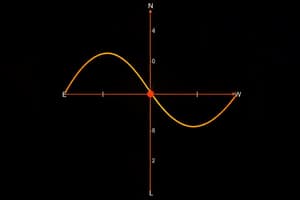Podcast
Questions and Answers
What does the Cayley-Hamilton Theorem state about square matrices?
What does the Cayley-Hamilton Theorem state about square matrices?
- A square matrix satisfies its own characteristic equation. (correct)
- A square matrix can be expressed as the sum of its eigenvalues.
- The characteristic equation has no relevance to a square matrix.
- A square matrix can only be inverted if it is diagonal.
The characteristic equation of a matrix can be found by calculating the determinant of (A + λI).
The characteristic equation of a matrix can be found by calculating the determinant of (A + λI).
False (B)
What is the first step in verifying the Cayley-Hamilton Theorem for a given matrix?
What is the first step in verifying the Cayley-Hamilton Theorem for a given matrix?
Find the characteristic equation of the matrix.
The Cayley-Hamilton Theorem can be used to find the __________ of a matrix.
The Cayley-Hamilton Theorem can be used to find the __________ of a matrix.
Match the following concepts with their definitions:
Match the following concepts with their definitions:
What is the role of the identity matrix (I) in finding the characteristic equation?
What is the role of the identity matrix (I) in finding the characteristic equation?
Substituting the matrix into the characteristic equation results in a non-zero matrix.
Substituting the matrix into the characteristic equation results in a non-zero matrix.
Describe one efficient application of the Cayley-Hamilton Theorem.
Describe one efficient application of the Cayley-Hamilton Theorem.
To express the inverse matrix in terms of lower powers of the original matrix, you multiply the characteristic equation by the __________ of the matrix.
To express the inverse matrix in terms of lower powers of the original matrix, you multiply the characteristic equation by the __________ of the matrix.
Which of the following is a step in finding the inverse of a matrix using the Cayley-Hamilton Theorem?
Which of the following is a step in finding the inverse of a matrix using the Cayley-Hamilton Theorem?
Flashcards
Cayley-Hamilton Theorem
Cayley-Hamilton Theorem
A theorem stating that any square matrix satisfies its own characteristic equation. In simpler terms, if you replace the variable in the characteristic equation with the matrix itself, the result will be the zero matrix.
Characteristic Equation
Characteristic Equation
An equation derived from a matrix by calculating the determinant of (A - λI), where 'A' is the matrix itself, 'λ' is a scalar variable, and 'I' is the identity matrix.
Substituting the Matrix
Substituting the Matrix
The process of replacing the variable 'λ' in the characteristic equation with the matrix itself.
Calculating Powers of a Matrix
Calculating Powers of a Matrix
Signup and view all the flashcards
Finding the Inverse of a Matrix
Finding the Inverse of a Matrix
Signup and view all the flashcards
Verifying the Cayley-Hamilton Theorem
Verifying the Cayley-Hamilton Theorem
Signup and view all the flashcards
Finding the Inverse using Cayley-Hamilton
Finding the Inverse using Cayley-Hamilton
Signup and view all the flashcards
Solving Problems using Cayley-Hamilton
Solving Problems using Cayley-Hamilton
Signup and view all the flashcards
Example: Inverse using Cayley-Hamilton
Example: Inverse using Cayley-Hamilton
Signup and view all the flashcards
Applications of Cayley-Hamilton
Applications of Cayley-Hamilton
Signup and view all the flashcards
Study Notes
Cayley-Hamilton Theorem
- The Cayley-Hamilton Theorem states that any square matrix satisfies its own characteristic equation.
- This means that if you substitute the matrix for the variable 'lambda' in the characteristic equation, the result will be the zero matrix.
Finding the Characteristic Equation
- The characteristic equation of a matrix is found by calculating the determinant of (A - λI), where A is the matrix, λ is a scalar, and I is the identity matrix.
- This is calculated using the general method of finding the determinant of (A - λI) or a shortcut method, such as finding the sum of the diagonal elements.
- The characteristic equation will be a polynomial equation.
Applications of Cayley-Hamilton Theorem
- Calculating Powers of a Matrix: The theorem can be used to calculate higher powers of a matrix efficiently. By substituting the matrix into its characteristic equation, you can express any power of the matrix in terms of lower powers of the matrix.
- Finding the Inverse of a Matrix: The Cayley-Hamilton Theorem can also be used to find the inverse of a matrix. Multiplying the characteristic equation by the inverse of the matrix and solving for the inverse will result in the inverse matrix being expressed in terms of lower powers of the original matrix.
Verifying the Cayley-Hamilton Theorem
- To verify the Cayley-Hamilton Theorem for a given matrix:
- Find the characteristic equation of the matrix.
- Substitute the matrix for 'lambda' in the characteristic equation.
- Simplify the resulting expression and verify that it equals the zero matrix.
Example of Using the Cayley-Hamilton Theorem
- To find the inverse of a matrix using the Cayley-Hamilton Theorem:
- Find the characteristic equation of the matrix.
- Multiply both sides of the characteristic equation by the inverse of the matrix.
- Simplify the equation to express the inverse matrix in terms of lower powers of the original matrix.
Using Cayley-Hamilton Theorem to Solve Problems
- The Cayley-Hamilton Theorem can be applied to solve problems where a matrix is given and you need to find its inverse or a higher power of the matrix.
- The theorem provides an efficient way to solve these kinds of problems, especially when dealing with large matrices.
Studying That Suits You
Use AI to generate personalized quizzes and flashcards to suit your learning preferences.




